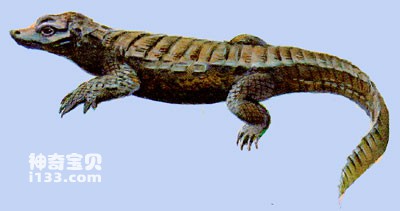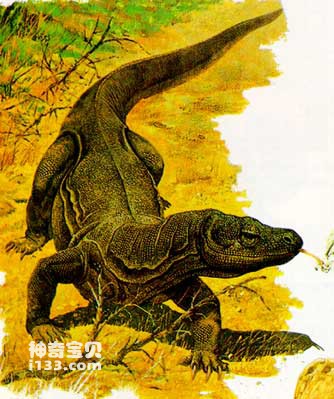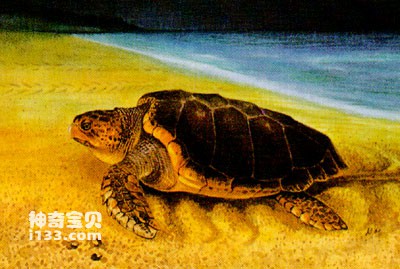The mass extinction of the dinosaurs at the end of the Cretaceous is an eternal mystery in the history of biology. Scientists have proposed one theory after another to try to explain the cause, but so far there is no conclusion that everyone can accept. The more popular theory is that the disaster caused by an asteroid impact on the earth led to the extinction of the dinosaurs, but this theory is not perfect. Because dinosaurs were the most successful animals on the earth at that time, their rich diversity was reflected in their different sizes, shapes, and lifestyles. If the disaster caused by an asteroid impact caused the extinction of the dinosaurs, then why are reptiles that are closely related to the dinosaurs, such as turtles, crocodiles, and lizards, able to survive the disaster and survive today? This cannot help but prompt people to look for other ideas to analyze the reasons for the extinction of dinosaurs.

Crocodile
Modern scientific analysis allows us to understand that in the distant era when the earth was just formed, there was basically no oxygen in the air, but the content of carbon dioxide was very high. Later, with the emergence of autotrophs, photosynthesis began the process of consuming carbon dioxide and producing oxygen, thus changing the Earth's atmospheric environment. At the same time, carbon dioxide is deposited in the formation as coal and petroleum through biological fixation on the one hand, and in the form of various carbonates through organic or inorganic processes on the other hand. This deposition is ongoing.
There is evidence that the concentration of carbon dioxide in the Mesozoic era when dinosaurs lived was very high, while the concentration of carbon dioxide in the subsequent Cenozoic era was lower. Is this change in atmospheric composition related to the extinction of the dinosaurs?

lizard
As we all know, every living thing needs an appropriate environment to live normally. Changes in the environment can often lead to the rise and decline of a species. When the environment is conducive to this species, it will thrive; otherwise, it will decline or even become extinct. Environmental factors include factors such as temperature and water, as well as the composition of the atmosphere. So, will changes in atmospheric composition affect the lives of living things? The answer is yes. For example, human life will be in danger in an environment with high carbon dioxide concentration, and some animals are even more sensitive to changes in carbon dioxide concentration than humans.
During the Mesozoic Era when dinosaurs lived, the content of carbon dioxide in the atmosphere was relatively high, indicating that dinosaurs were well adapted to atmospheric environments with high carbon dioxide concentrations. Perhaps only in that atmospheric environment can they live well. Although mammals had also appeared at that time, they had never developed greatly. Perhaps this was because the atmospheric composition and other environments were not very favorable to them, so they had been in a weak position and developed slowly during the Mesozoic Era. As time went by, by the end of the Cretaceous, the atmospheric environment had undergone tremendous changes. The content of carbon dioxide decreased and the content of oxygen increased. This unfavorable environment for dinosaurs may be reflected in two aspects: 1. The body of dinosaurs has changed. Discomfort, in a new environment, it is easy to get sick, and the disease will spread like the plague. 2. The new atmospheric environment is more suitable for the survival of mammals, and mammals become more advanced and adaptable competitors. Under the influence of these two factors, the dinosaurs eventually became extinct. Those relict reptiles are among the few reptile species that can adapt to both the old environment and the new environment.

sea turtle
Therefore, the asteroid impact may have played a certain role in the extinction of the dinosaurs, but it does not seem to be the most critical factor.
There are two starting points for the theory that changes in atmospheric composition caused the extinction of the dinosaurs. One is that the atmospheric composition of the Mesozoic was different from that of modern times. Modern science has been able to prove this. Another is that every living thing needs the right atmosphere to survive. It is also not difficult for modern science to verify this.
There was almost no oxygen in the atmosphere in ancient times, but high levels of carbon dioxide. Later, due to the emergence of living things, the process in which the content of carbon dioxide in the atmosphere gradually decreased and the content of oxygen gradually increased under photosynthesis may explain many phenomena in the history of biological evolution. For example, the Cambrian explosion of life is also a difficult mystery in the history of evolution. Changes in atmospheric composition can also explain this, because animals cannot directly use inorganic substances for photosynthesis. Its origin lags behind the origin of plants and must occur when the oxygen content in the atmosphere reaches a considerable level. Therefore, the Cambrian explosion of life must be guaranteed by the oxygen content in the atmosphere reaching a certain level, and this has been proven by science.
animal tags:
We created this article in conjunction with AI technology, then made sure it was fact-checked and edited by a Animals Top editor.